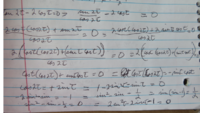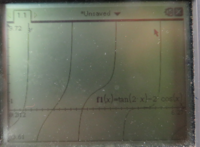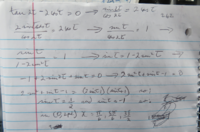First, please read Dan's excellent response. But I think one reason you have may be having trouble here is because of a blind spot on the specifics of this problem..
so,what you are saying is this: before you try to divide something into something, make sure the divisor is not or ,cannot be = to zero?
This is always true, not just with respect to the specific topic we are discussing. And if you want to divide by a variable you either have to make sure in advance that it cannot be zero or you have to proceed by cases, case 1 not dividing when the variable is zero and case 2 dividing when it is not.
And 2cos t can = zero here? That is where the mrub is for me. I mean, tan(2t) - 2cos(t) doesn't have to equal zero just because 2cos(t) = zero.
Oh but it certainly does. First, let's note that the cosine function can equal zero in the interval you are concerned with.
[MATH]cos(t) = 0 \iff t = \dfrac{(2k - 1) \pi}{2} \text { and } k \in \mathbb Z.[/MATH]
You know that perfectly well. The cosine function has an infinite number of x-intercepts, and they are periodically placed. In your specific problem, the argument is confined to the interval (0, 2 * pi). In that interval, there are exactly two values of t where the cosine function is zero, namely
[MATH]cos \left ( \dfrac{\pi}{2} \right ) = 0 \text { and } cos \left ( \dfrac{3 \pi}{2} \right ) = 0 \implies \\
2cos \left ( \dfrac{\pi}{2} \right ) = 0 \text { and } 2cos \left ( \dfrac{3 \pi}{2} \right ) = 0[/MATH]The tangent function also has an infinite number of x-intercepts, and they too are periodically placed.
[MATH]tan(t) = 0 \iff t = m \pi \text { and } m \in \mathbb Z.[/MATH]
Now for your proof
[MATH]cos(t) = 0 \implies \exists \text { an integer } k \text { such that } t = \dfrac{(2k - 1) \pi}{2} \implies\\
2t = \cancel 2 * \dfrac{(2k - 1) \pi}{\cancel 2} = (2k - 1) \pi\\
\text {But } k \text { is an integer } \implies (2k - 1) \text {is an integer} \implies\\
tan(2t) = 0.[/MATH]In fact, [MATH]cos(t) = 0 \iff tan(2t) = 0.[/MATH]
I think you are forgetting that the tangent function = sine over cosine and thus is not independent of the sine and cosine. Your concern would be correct if you were dealing with two independent functions, but you are not.
Looking at the specific values of t that make 2cos(t) = 0 for your problem, let's see what the specific values are for 2t and so for tan(2t).
[MATH]t = \dfrac{\pi}{2} \implies 2t = \pi \implies tan(2t) = 0 \text { and}\\
t = \dfrac{3 \pi}{2} \implies 2t = 3 \pi \implies tan(2t) = 0.[/MATH]
You say 3 pi is out of range. No. It is not stipulated that 2t < 2 * pi, just that t < 2 * pi.
am pretty dense and can't see how to prove 2cos (t) can equal zero...but I guess it can provided tan (2t) also equals zero. But this would hold then, for any equation of this type, ,any equation with two terms separated by a minus sign, that equals zero, no? I am slow-brained, especially at this small hour of the morning. I need to think this thing through, which I certainly will on the morrow. Thanks for setting it all out. I will post the results of my cogitations.
You are not dense. Things like independence are fundamental and perhaps not stressed enough to beginning students.
And yes
[MATH]a - b = 0 \iff a = b\\
\therefore a - b = 0 \text { and } b = 0 \implies a = 0.[/MATH]






